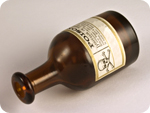
Lindane pesticide banned by the EPA, but still allowed by FDA in children's products
Tuesday, March 27, 2007 by: Christian Evans
Tags: lindane, toxic chemicals, personal care products
- TAKE IT DOWN Act advances in Congress amid free speech concerns
- Hospital staffers sound alarm after 10 nurses were diagnosed with BRAIN TUMORS
- Analysis: The coming economic collapse, a mass uprising and Trump's three secret weapons to halt the growing revolt
- Widespread social and economic unrest: Steve Quayle issues urgent financial warning of imminent asset collapse in new interview with Mike Adams
- Fauci is back in the limelight, and he’s busy promoting a future COVID or FLU pandemic
- Israeli lobbyists boast of controlling US national security policy in leaked AIPAC audio
- Mike Adams releases country western hit single: Goin’ Back in Time is Comin’ Home
- Tulsi Gabbard leads charge against the Biden regime’s global censorship of the 'Disinformation Dozen'
- Aerosolized bioweapons? Strange “diploid biomasses” falling out of the sky in Florida captured under the microscope
- Kiss Your Genetic Privacy Good-Bye! 23andMe Gets Green Light to Sell Your Intimate Genetic Details to Anyone They Want
- U.S. lawmakers investigate Meta over alleged China collaboration
- CLOT SHOT PLANDEMIC UNFOLDING: Fibrous, rubbery clots caused by covid injections have prion-like seeding activity
- New studies ignite debate: Fluoride linked to autism and ADHD, prompting calls for policy reassessment
- Children’s Health Defense stands firm: Based on SCIENCE and personal experiences, the MMR vaccine is NEITHER SAFE nor EFFECTIVE
- Defunding DEADLY mRNA jabs: Government funding for mRNA technology being scrutinized and sidelined until proven "safe and effective" for real
- Sen. Ron Johnson accuses CDC official in charge of COVID-19 injections of deleting records amid Congressional GOP scrutiny
- DEATH by VACCINE or face PRISON time: Canadian Freedom Convoy leaders CONVICTED for protesting forced vaccination during the Covid Plandemic
- Shedding light on the dark side of MMR vaccines: How vaccinated individuals SPREAD MEASLES & put the vulnerable at risk
- Fauci is back in the limelight, and he’s busy promoting a future COVID or FLU pandemic
- Tulsi Gabbard leads charge against the Biden regime’s global censorship of the 'Disinformation Dozen'
- Aerosolized bioweapons? Strange “diploid biomasses” falling out of the sky in Florida captured under the microscope
- Analysis: The coming economic collapse, a mass uprising and Trump's three secret weapons to halt the growing revolt
- Kiss Your Genetic Privacy Good-Bye! 23andMe Gets Green Light to Sell Your Intimate Genetic Details to Anyone They Want
- Widespread social and economic unrest: Steve Quayle issues urgent financial warning of imminent asset collapse in new interview with Mike Adams
- U.S. lawmakers investigate Meta over alleged China collaboration
- Mike Adams releases country western hit single: Goin’ Back in Time is Comin’ Home
- Chemtrails unveiled: How the CIA and Big Business are manipulating the weather for profit
- Curcumin’s ancient healing power supercharges muscle recovery, and its effects are compounded with anti-inflammatory foods and supplements
- Tulsi Gabbard takes aim at censorship: Justice for the ‘Disinformation Dozen’
- China’s counter-tariff strategies: A new chapter in the U.S.-China trade war
- CLOT SHOT PLANDEMIC UNFOLDING: Fibrous, rubbery clots caused by covid injections have prion-like seeding activity
- Israeli lobbyists boast of controlling US national security policy in leaked AIPAC audio
- European Court of Justice: Healthcare professionals who promoted or administered COVID-19 vaccines are CRIMINALLY LIABLE for any harm caused
- Defunding DEADLY mRNA jabs: Government funding for mRNA technology being scrutinized and sidelined until proven "safe and effective" for real
- DEATH by VACCINE or face PRISON time: Canadian Freedom Convoy leaders CONVICTED for protesting forced vaccination during the Covid Plandemic
- U.S. approves new Russian ambassador as diplomatic thaw continues
- Newly released JFK files reveal Pentagon's role in creating Lyme disease and covid in the same lab
- Analysis: The coming economic collapse, a mass uprising and Trump's three secret weapons to halt the growing revolt
- Mike Adams releases country western hit single: Goin’ Back in Time is Comin’ Home
- Aerosolized bioweapons? Strange “diploid biomasses” falling out of the sky in Florida captured under the microscope
- Kiss Your Genetic Privacy Good-Bye! 23andMe Gets Green Light to Sell Your Intimate Genetic Details to Anyone They Want
- European Court of Justice: Healthcare professionals who promoted or administered COVID-19 vaccines are CRIMINALLY LIABLE for any harm caused
- Federal employees whine over DOGE's new directive requiring them to do a 5-point summary of weekly accomplishments
- Dr. Mike Yeadon releases 15-minute testimony - WATCH - about genocidal intent of COVID “vaccines”
- The Health Ranger releases “Vaccine Zombie” song and music video, using AI-animated zombies for the music video
- U.S. approves new Russian ambassador as diplomatic thaw continues
- Government waste exposed: Hegseth supports Musk’s demand for accountability from federal workers
- Trump reverses course on Gaza plan, says “nobody is expelling Palestinians”
- Now you can HEAR chemistry: Health Ranger translates molecules into music in stunning video demonstration that will blow your mind (and your ears)
- 5 Simple steps to boost your brainpower: How to strengthen executive function in a distracted world
- EPA advisor admits the agency is funneling billions to climate groups ahead of Trump’s return to White House
- A lack of integrity in Academia: Harvard professor found GUILTY of fraudulent research to promote CRT theory
- Rep. Nancy Mace introduces bill to ban biological males from female facilities on federal property
- Survival 101: Effective EMF blocking techniques
- Red Cross issues warning to stop blood plasma donations from vaccinated people
- Scientists confirm: GENIUS brain function can be spontaneously unleashed in humans without any apparent cause
- EPA advisor admits the agency is funneling billions to climate groups ahead of Trump’s return to White House
- HYSSOP: What research reveals about the health benefits of this ancient holy herb
- Two containers with completed ballots fall out of truck in Florida
- Newly released JFK files reveal Pentagon's role in creating Lyme disease and covid in the same lab
- Global leaders unite to clamp down on “misinformation” with UN-backed Cascais Declaration
- BREAKING: 2025 NDAA authorizes mandatory military draft of WOMEN across America… as Pentagon pursues global NUCLEAR war with both Russia and China at the same time
- Michael Yon warns of a ZIONIST TAKEOVER in Trump’s second administration
- Mike Adams releases country western hit single: Goin’ Back in Time is Comin’ Home
- Ozempic and Wegovy weight loss drugs are injectable LIZARD VENOM PEPTIDES that may unleash a devastating wave of organ failure… side effects align with symptoms of SNAKE BITES
- The Health Ranger releases “Vaccine Zombie” song and music video, using AI-animated zombies for the music video
- BOMBSHELL: DNA testing kits are a SCAM to develop ethnic-specific bioweapons
- Israeli soldiers accused of even more torture and abuse in the West Bank
- These 13 countries just signed an agreement to engineer a global FAMINE by destroying food supply
- NASA admits that climate change occurs because of changes in Earth’s solar orbit, and NOT because of SUVs and fossil fuels
- RFK Jr. clears key hurdle: Sen. Susan Collins backs controversial HHS nominee, signaling a new era for health policy
- Sermon 30: How Jesus reveals Caesar’s FAKE CURRENCY and FALSE AUTHORITY
While environmental health groups around the country applauded the EPA for the first step in abolishing lindane, these same groups are now calling for a phaseout of the remaining uses of lindane in pharmaceutical products in the U.S. that do more harm than good.
Lindane - also known as gamma hexachlorocyclohexane (HCH) and benzane hexachloride (BHC) - is found most commonly in products that treat head and crab (pubic) lice, such as shampoo that kills the lice and their eggs. It is prescribed for use only "after safer medications have failed or have caused side effects," but is still used with alarming frequency.
According to the Pesticide Action Network North America (PANNA), "it is a known neurotoxin that can cause seizures, damage the nervous system, and weaken the immune system. Exposure might also cause cancer and disrupt hormone systems. Since lindane is highly persistent and travels globally through the air and water, its use poses an exposure risk to people far from the source."
This chemical has been banned for use on pets and seeds, but still we continue to allow its use on our children's heads? The FDA must learn to keep our children healthy and safe by not favoring the interests of corporations who continue to profit from sales of products containing this toxic chemical.
Actually, the entire warning that accompanies this product is detailed and shocking, and deserves to be printed in full: "Only use Lindane Shampoo if you have already tried other safer treatments and experienced severe side effects or the treatments did not work. Seizures and death have occurred following repeated or prolonged use of Lindane Shampoo, and rarely after a single use according to the directions. Do not use Lindane Shampoo if you have a history of seizures or certain skin conditions where the skin is irritated or broken (eg, atopic dermatitis, psoriasis) or to treat premature infants.
"Use Lindane Shampoo with extreme caution to treat infants or children, if you are elderly, or if you weigh less than 110 lbs (50kg) because you may be at greater risk of serious nervous system side effects. Follow the directions for using Lindane Shampoo very carefully. You may experience symptoms such as continued itching after using Lindane Shampoo, even if it has worked well. If itching continues, contact your doctor. Do not use more of Lindane Shampoo or use Lindane Shampoo more often than prescribed by your doctor."
Children put at extreme risk by Lindane
An estimated 6-12 million people in the U.S. get lice each year, and a good majority of those are children. Lindane has been used as a topical scabicide and pediculicide for years, and in most cases, acute lindane toxicity is most lethal to the elderly and children typically manifested as grand mal seizures. Lindane is also a significant contaminate in urban sewer systems and can pollute drinking water.Smaller children also have a larger risk of systematic exposure, but it is still not known whether the developing nervous system of children increases their susceptibility to such toxicity. However, case controlled research does show a significant association between brain tumors in children and the use of lice shampoos containing lindane.
Lindane and its breakdown products persist in the environment, posing a risk to people and wildlife that may be exposed long after the pesticide is applied. All uses of this noxious compound "have already been banned in at least 52 countries, including most recently, Mexico," and its use is restricted or banned in most of Europe. Pharmaceutical uses of lindane for lice and scabies have been banned in California since 2002, and are currently being questioned in legislation for a similar ban in states like Michigan and New York, according to PANNA.
The health dangers of lindane
Not only is lindane highly ineffective, it's also dangerous. According to Wikipedia:• Lindane is a proven carcinogenic and is cited by the EPA as acutely toxic.
• It is a suspected endocrine disruptor, meaning it disrupts hormones that regulate growth and reproductive health.
• Like other agricultural pesticides, lindane is very easily introduced into the water and food supply of an area through rainfall, and can lead to low-level lindane poisoning throughout the local community
• Lindane is volatile, with roughly 90% entering the atmosphere and ultimately being deposited into rain.
• Lindane should not be kept on the head longer than 4 minutes and should not be covered during this time under any circumstances. Rinse only with warm water - hot water is not safe and is not recommended.
Lindane shampoo acts and can permeate your skin, entering your blood supply and affecting your brain and nervous system. It can cause seizures and death in people who use the product too much or too often, and it also can cause seizures even when used as directed.
Be careful - Lindane Shampoo is also sold under the one-percent formula as Kwell shampoo and lotions (among other brand names) used to treat human scabies infection, head lice and other ectoparasites. The topical preparation has a half-life of approximately 18 hours.
Research scientists "strongly recommend its removal from the market" because of its low efficacy and high toxicity. It may also interact with certain medications. According to a 2003 study from the U.S. Centers for Disease Control and Prevention, 62% of U.S. residents sampled carry the insecticide Lindane in their body.
Effective alternatives to fight lice and scabies exist and are readily available, including Vaseline, mayonnaise, or the application of regular shampoos and oils. Even careful combing with a fine-tooth comb specially designed for lice control is a viable option.
If overdose is suspected, call your local poison control center or emergency room immediately. Symptoms of an overdose could include bloody urine, irregular heartbeat, nausea, restlessness, seizures, unsteadiness, or vomiting.
A public domain U.S. government document at FDA.gov provides further information related to lindane, and is available at: (http://www.fda.gov/cder/drug/infopage/lindan...).
Action item:
Petition the FDA to ban lindane! Use the web form at: http://action.panna.org/campaign.jsp?campaig...Lindane at FETCH.news
Get independent news alerts on natural cures, food lab tests, cannabis medicine, science, robotics, drones, privacy and more.
Take Action: Support Natural News by linking to this article from your website
Permalink to this article:
Embed article link: (copy HTML code below):
Reprinting this article:
Non-commercial use OK, cite NaturalNews.com with clickable link.
Follow Natural News on Facebook, Twitter, Google Plus, and Pinterest
Science News & Studies
Medicine News and Information
Food News & Studies
Health News & Studies
Herbs News & Information
Pollution News & Studies
Cancer News & Studies
Climate News & Studies
Survival News & Information
Gear News & Information
News covering technology, stocks, hackers, and more



"Big Tech and mainstream media are constantly trying to silence the independent voices that dare to bring you the truth about toxic food ingredients, dangerous medications and the failed, fraudulent science of the profit-driven medical establishment.
Email is one of the best ways to make sure you stay informed, without the censorship of the tech giants (Google, Apple, Facebook, Twitter, YouTube, etc.). Stay informed and you'll even likely learn information that may help save your own life."
–The Health Ranger, Mike Adams













































